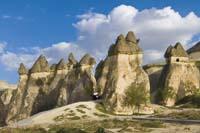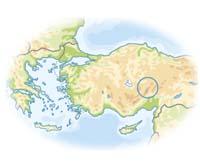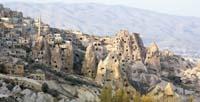Cappadocia, stone village

One of the most spectacular landscapes in the world is in Turkey, in the historical territory of Cappadocia. Ravines, canyons and curious formations have given a magical and unique air to this central area of Anatolia.
10 million years ago, the oven and volcanic dust covered the plain with a mineral called tufa. This mineral does not support well the attacks of rain, changes of temperature and air, so with the passage of time nature has been adapting the area forming surprising valleys, strange conical columns and an indescribable landscape.

One of the most surprising endemic structures in Cappadocia is the "witch chimneys". These volcanic monoliths are formed by tobos at the bottom and basalts by basalts and andesis. The highest and most spectacular reach a height of 40 meters. But when they lose the txapela that protects them they begin to get rid of.
Man has also taken advantage of the natural caves and caves of this territory. Christians, Hittites and Byzantines organized numerous monasteries, chapels and churches on the rocks. One of the best known is the "Dark Church". For lack of light, X. and XI. the frescoes of the centuries remain.

But the civilizations that lived in Cappadocia did much more than take advantage of the natural caves, as they dug with their hands to create new rock spaces. This was possible thanks to the flaccidity and adaptability of the rock formed by tufas. Thus, the first Christians who came to Cappadocia fleeing the Arab invaders built around 37 cities. and VIII. for centuries. Some of them had capacity for 10,000 people communicated through large labyrinths.
Buletina
Bidali zure helbide elektronikoa eta jaso asteroko buletina zure sarrera-ontzian











